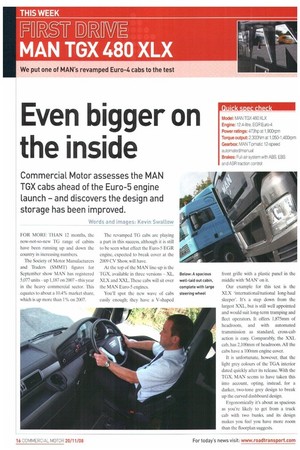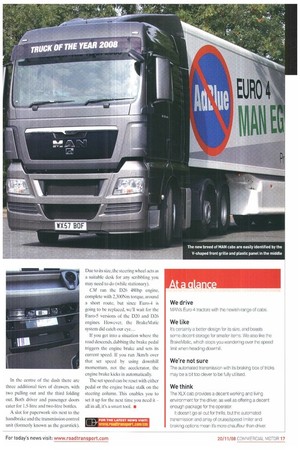Even bigger on the inside
Page 16

Page 17

If you've noticed an error in this article please click here to report it so we can fix it.
Commercial Motor assesses the MAN TGX cabs ahead of the Euro-5 engine Launch and discovers the design and storage has been improved.
Words and images: Kevin Swallow
FOR MORE THAN 12 months, the now-not-so-new TG range of cabins have been running up and down the country in increasing numbers.
The Society of Motor Manufacturers and Traders (SMMT) figures for September show MAN has registered 5,077 units — up 1,187 on 2007 — this year in the heavy commercial sector. This equates to about a 10.4% market share, which is up more than I% on 2007. The revamped TG cabs are playing a part in this success, although it is still to be seen what effect the Euro-5 EGR engine, expected to break cover at the 2009 CV Show, will have.
At the top of the MAN line-up is the TGX, available in three versions — XL. XLX and X.XL. These cabs will sit over the MAN Euro-5 engines.
You'll spot the new wave of cabs easily enough; they have a V-shaped front grille with a plastic panel in the middle with 'MAN' on it.
Our example for this test is the XLX international/national long-haul sleeper'. It's a step down from the largest XXL, but is still well appointed and would suit long-term tramping and fleet operators. It offers 1,875mm of headroom, and with automated transmission as standard, cross-cab action is easy. Comparably, the XXL cab, has 2,100mm of headroom. All the cabs have a 100mm engine cover.
It is unfortunate, however, that the light grey colours of the TGA interior dated quickly after its release. With the TGX, MAN seems to have taken this into account, opting, instead, for a darker, two-tone grey design to break up the curved dashboard design.
Ergonomically it's about as spacious as you're likely to get from a truck cab with two bunks, and its design makes you feel you have more room than the floorplan suggests.
In the centre of the dash there are three additional tiers of drawers, with two pulling out and the third folding out. Both driver and passenger doors cater for 1.5-litre and two-litre bottles.
A slot for paperwork sits next to the handbrake and the transmission control unit (formerly known as the gearstick). Due to its size, the steering wheel acts as a suitable desk for any scribbling you may need to do (while stationary).
CM ran the D26 480hp engine, complete with 2,300Nm torque, around a short route, but since Euro-4 is going to be replaced, we'll wait for the Euro-5 versions of the D20 and D26 engines However, the BrakeMatic system did catch our eye...
If you get into a situation where the road descends, dabbing the brake pedal triggers the engine brake and sets its current speed. If you run 3km/h over that set speed by using downhill momentum, not the accelerator, the engine brake kicks in automatically.
The set speed can be reset with either pedal or the engine brake stalk on the steering column. This enables you to set it up for the next time you need it — all in all, it's a smart tool. •
We drive
MAN's Eurc-4 tractors with the newish range of cabs.
We like
It's certainly a better design for its size, and boasts some decent storage for smaller items. We also like the BrakeMatic, which stops you wandering over the speed limit when heading downhill.
We're not sure
The automated transmission with its braking box of tricks may be a bit too clever to be fully utilised.
We think
The XLX cab provides a decent working and living environment for the driver, as well as offering a decent enough package for the operator.
It doesn't go all out for thrills, but the automated transmission and array of cruise/speed limiter and braking options mean it's more chauffeur than driver.




























































































































































